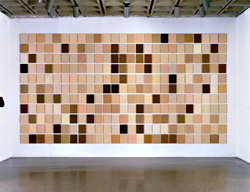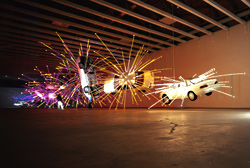Don’t be misled by the seeming simplicity of Byron Kim’s monochromatic canvases. His paintings are abstractions on one level, sure—particles of people depicted solely by color, or his own children identified by the swirls of hair on the tops of their heads. But on another level, Kim’s paintings are deeply accurate—and emotional—portraits of perception and memory that are so sharply true they’re almost jarring. In its essence, Kim’s work demonstrates the art of observation. His nostalgic Miss. Mushinski. (First Big Crush), is nothing more than a rectangle comprising neat horizontal stripes in dark green and blue. Yet it’s hard not to delight in the innocent truth it contains about the fragmentation of memory: This is apparently the pattern from a shirt Kim wore to school as a boy for three weeks in a row after his adored teacher complimented him on it. For 46 Halsey Drive, Wallingford, CT., 06492, Kim asked his family to recall the color of one of their past homes, offering them paint samples to choose from in various shades of pink. The result was an array of 12 or so shades, which Kim then painted in stripes across a canvas. Which color is accurate? They all are, since memory is a personal place quite apart from reality. In his experiments with skin tone, most notably the 275 monochromatic panels of Synecdoche (pictured), which debuted at the Whitney Biennial in 1993, he reduces his models to their skin color, showing how an issue as socially volatile and oppressive as racial differentiation can be insightful and beautiful in the context of art. While his series of paintings of a changing sky in brushes of white and swaths of blue don’t yield the same effect his portraits do, they capture, in a quiet way, all the monotony and nuance of the sky—the sort of details that usually only a child might notice—and evoke a summer day lying on the ground with nothing to do but look up and wonder. SUE PETERS
Byron Kim
Color is worth 1,000 words in his monochromatic paintings.








